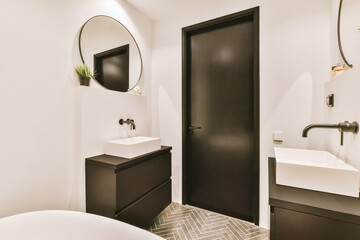A fresh bathroom can be a huge boost for your mood and your home’s resale value. If you are tired of a tired old bathroom, it’s time to start thinking about remodeling.

While there are some DIY projects that can be done, many bathroom remodels are complex and require skilled work. Hiring a professional contractor can save you time and money in the long run.
The tile in your bathroom is often a focal point and an essential part of the room’s design. Choose the right material to fit your goals and expectations.
Ceramic and porcelain tile are great choices for the bathroom since they are durable and easy to maintain. They also come in a variety of colors and designs.
Porcelain tiles are denser than ceramic and harder-wearing, making them a good choice for the shower floor. This type of tile is also less slippery than ceramic, so you’ll be able to walk around in your new shower without slipping.
Natural stone tile is another popular option for the shower and floor of your bathroom. These are made of marble, granite, limestone, and other types of rock, and they offer a luxurious look for your space.
A note of caution, however: While natural stone is a luxury material that’s usually more expensive than other tile options, it can be difficult to install and requires professional help.
In addition to bathroom flooring, you can also add tile to your walls. It’s a great way to add color, accent a wall, or even create a backsplash behind the sink.
While it’s important to keep your budget in mind, you can use tile to update your room before a full remodeling project. There are several ways to do this, including installing decals, painting the tiles, and adding new flooring.
Decals are a cheap and effective solution to cover up cracked, grody, or out-of-date tiles. They’re available in a wide range of colors and patterns, and they stick to clean tile, so you can get the job done quickly without replacing everything.
If you’re unsure of how to go about painting your tile, ask a paint expert for guidance. Some types of tile are better suited to certain types of paint, so you may need to test an area before covering the entire bathroom.
Once you have the paint ready, it’s time to start preparing your bathroom for tile installation. First, you should remove the threshold at your doorway to make it easier to get to your tiles.
A bathroom remodel can have an enormous impact on your home’s value. It can also provide a space that’s more comfortable for you and your family. However, a bathroom remodeling project can be expensive, so it’s important to plan carefully and make sure you have a budget in place before embarking on the project.
Concrete is a great option for many bathroom designs because it can be customized to fit your specific needs and is a relatively low-cost material. It can be used in a wide range of styles, from modern to traditional. It’s also highly durable and resistant to scratches and heat, making it an excellent choice for bathrooms.
Another benefit of concrete for a bathroom remodel is that it’s extremely easy to clean. You can sweep it, vacuum it, dry-mop it, or wet-mop it as needed. You can even wash it with soap and water or vinegar, as long as you don’t use too much of these cleaners, as they could stain the concrete.
When you’re laying out your new bathroom, one of the first things to do is locate your plumbing drain lines and supply lines in the slab foundation. This will make sure that the new pipes will work with the existing plumbing.
Once you have the plumbing and supply lines located, you can draw a layout for your bathroom. It’s best to do this before you cut into the concrete, as this will make it easier to create the exact bathroom layout that you want.
After the bathroom layout is finalized, you can start the next step in your bathroom remodel: removing the existing flooring and putting down the new floors. You will want to get the floors as level as possible before tiling, and you can do this by using a self-leveling compound.
